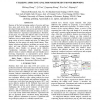TMM
2010
13 years 7 months ago
2010
Communication between humans deeply relies on the capability of expressing and recognizing feelings. For this reason, research on human-machine interaction needs to focus on the re...
INTERSPEECH
2010
13 years 7 months ago
2010
We carry out two studies on affective state modeling for communication settings that involve unilateral intent on the part of one participant (the evoker) to shift the affective s...
CONNECTION
2010
13 years 9 months ago
2010
Abstract. Despite the great amount of knowledge produced by the neuroscientific literature affective phenomena, current models tackling noncognitive aspects of behavior are often b...
ICIP
2009
IEEE
13 years 10 months ago
2009
IEEE
Because of the fast increasing number of movies and long time span each movie lasts, novel methods should be developed to help users browse movies and find their desired clips eff...
TSD
2010
Springer
13 years 10 months ago
2010
Springer
In this paper we present our study on expressive gibberish speech synthesis as a means for affective communication between computing devices, such as a robot or an avatar, and thei...
TROB
2008
14 years 10 days ago
2008
Abstract--Investigation into robot-assisted intervention for children with autism spectrum disorder (ASD) has gained momentum in recent years. Therapists involved in interventions ...
IJMMS
2007
14 years 10 days ago
2007
Affective reasoning plays an increasingly important role in cognitive accounts of social interaction. Humans continuously assess one another's situational context, modify the...
IJMMS
2007
14 years 10 days ago
2007
How we design and evaluate for emotions depends crucially on what we take emotions to be. In affective computing, affect is often taken to be another kind of information - discret...
IWC
2006
14 years 12 days ago
2006
Conveyance and recognition of human emotion and affective expression is influenced by many factors, including culture. Within the user modeling field, it has become increasingly n...
IJMMS
2008
14 years 13 days ago
2008
Generally, an experienced therapist continuously monitors the affective cues of the children with Autism Spectrum Disorders (ASD) and adjusts the course of the intervention accord...




